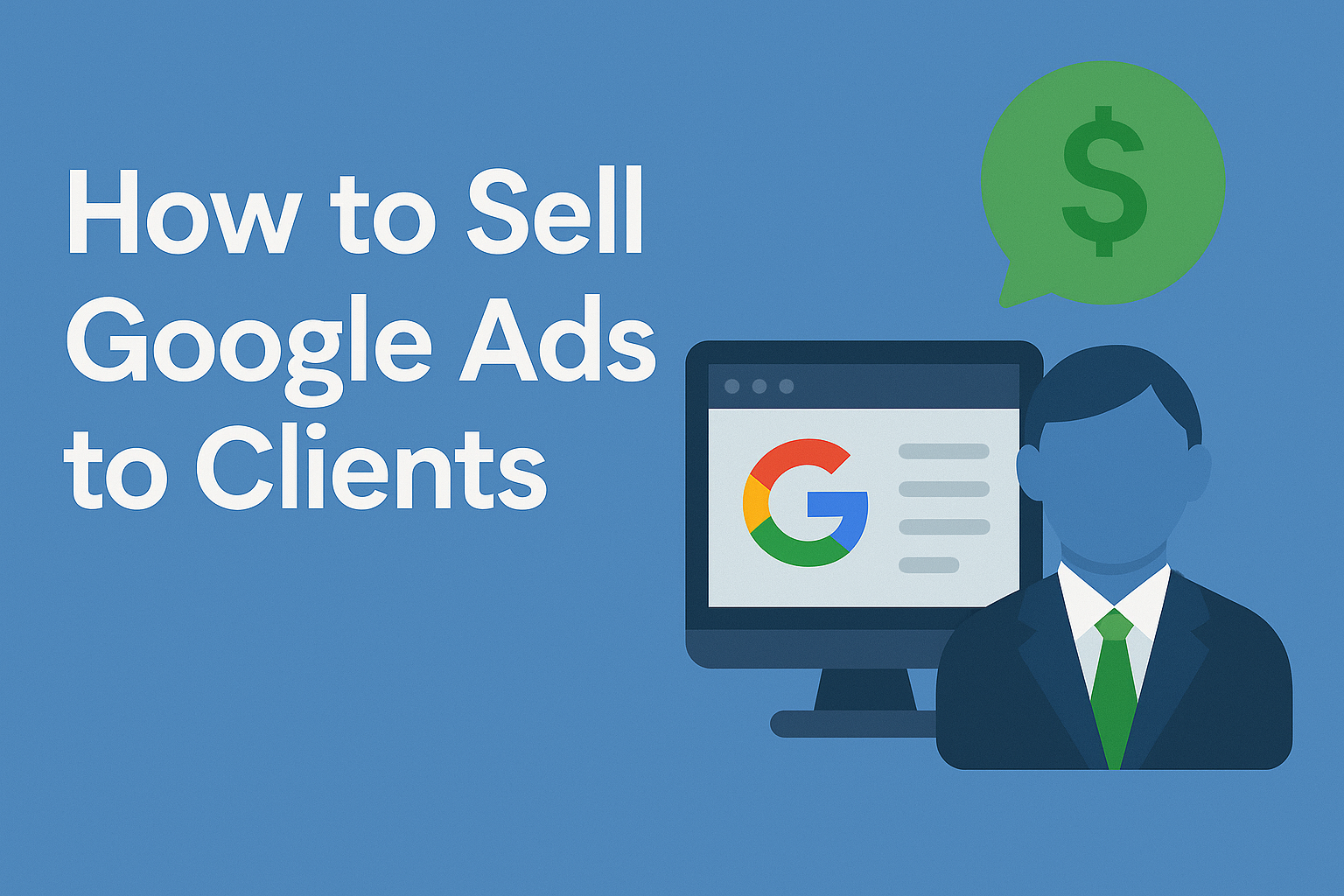Google Ads is one of the most powerful tools for driving targeted traffic and measurable ROI for businesses. For agencies, offering Google Ads services not only diversifies your offerings but also provides a scalable revenue stream. However, many agencies struggle with how to effectively sell these services to clients—especially those unfamiliar with paid search or skeptical about its value.
This guide breaks down the entire sales process step by step, from understanding your client’s goals to creating irresistible offers and closing the deal. If you’re an agency looking to sell Google Ads confidently and consistently, this post will give you the strategy and structure to do it right.
Understanding Client Needs and Goals
Before pitching any Google Ads service, it’s critical to understand what the client actually needs. Selling without this step leads to poor campaign alignment and client dissatisfaction.
Start by asking targeted questions:
- What are their short-term and long-term business goals?
- Who is their ideal customer?
- What’s their average customer value or lifetime value?
- What marketing channels have they used before? Were they successful?
This discovery process helps you assess whether Google Ads is a good fit. For instance, a client with a tight budget but high customer lifetime value might benefit from a narrow, high-intent search campaign. Meanwhile, a local service business could thrive using location-based ads with strong call-to-action extensions.
You also need to understand their current online presence. If their website is slow or lacks clear conversion paths, the ad campaign will likely underperform. Set expectations early—Google Ads isn’t a magic switch; it’s a strategic investment.
The better you understand their business, the more confidently you can position your service as a tailored solution rather than a generic package.
Positioning Google Ads as a Solution
Once you’ve identified the client’s goals and pain points, the next step is to clearly connect those to what Google Ads can deliver. Many clients won’t understand the platform’s technical aspects, so focus on outcomes, not features.
Here’s how to position Google Ads effectively:
- For Lead Generation: Emphasize that Google Ads targets people actively searching for services they offer. Explain how search intent leads to higher-quality leads.
- For E-commerce: Highlight how Shopping Ads and Performance Max campaigns can showcase products directly in search results, increasing visibility and conversion rates.
- For Brand Visibility: Show how Display and YouTube ads can build top-of-mind awareness while still offering measurable engagement metrics.
Avoid overwhelming the client with platform jargon. Instead, use relatable examples tied to their business. For instance, “Imagine someone searching ‘emergency plumber near me’—your ad could appear at the top with a call button.”
Also, explain how Google Ads gives detailed analytics—so they’ll know exactly what’s working. This transparency builds trust and differentiates your service from “black box” marketing efforts.
Building the Right Offer
Your offer should be tailored to the client’s budget, goals, and technical readiness. A one-size-fits-all package rarely works with Google Ads, especially when clients have varying levels of experience and expectations.
Here’s how to structure your offer effectively:
- Service Tiers: Create clear tiers such as “Starter,” “Growth,” and “Scale.” Each should define exactly what’s included—account setup, keyword research, ad copywriting, landing page review, conversion tracking, and monthly reporting.
- Setup vs. Management: Differentiate between one-time setup fees (campaign creation, conversion tracking installation) and ongoing monthly management (optimizations, A/B testing, reporting).
- Add-On Services: Offer complementary services like landing page creation, call tracking, or remarketing campaigns. This increases the average contract value while delivering better performance.
- Pricing Models: Choose between flat-rate, percentage of ad spend, or performance-based pricing. For most small to mid-size clients, flat monthly fees are easiest to understand and scale.
Be transparent about what’s included and what isn’t. This prevents confusion and builds credibility. Also, always tie your offer back to outcomes—clients care more about leads and sales than impressions and click-through rates.
Creating a High-Impact Proposal
A well-structured proposal can make the difference between a closed deal and a lost lead. It needs to be professional, results-oriented, and easy to understand.
Include these essential elements:
- Client Objectives: Reiterate their goals to show you’ve been listening—whether it’s generating 30 new leads per month or improving online sales by 25%.
- Recommended Strategy: Outline the specific Google Ads campaigns you’ll launch (e.g., Search for high-intent keywords, Display for remarketing), along with platforms and ad types. Avoid technical overload—focus on strategy and outcomes.
- Estimated Results and KPIs: Provide realistic projections based on industry benchmarks (e.g., expected CTR, CPC, lead volume). Clarify that these are estimates, not guarantees.
- Timeline: Break down your plan into phases—initial setup, campaign launch, optimization checkpoints, and monthly reporting cycles.
- Pricing Summary: Clearly show your pricing, including setup fees, monthly management, and any optional add-ons.
- Call to Action: End with a clear next step—book a strategy call, sign the agreement, or schedule onboarding.
The proposal should be visually clean and easy to skim. Use headings, bullet points, and simple charts if needed. Avoid fluff and filler—your goal is to communicate value quickly and clearly.
Pitching and Closing the Deal
Once the proposal is ready, it’s time to present it—this is where your communication skills matter as much as your marketing expertise.
1. Focus on Outcomes, Not Features
During the pitch, emphasize how Google Ads will directly impact the client’s goals. Use plain language like, “This strategy is designed to bring in 20–30 qualified leads per month,” rather than talking about CPCs or campaign types.
2. Anticipate and Handle Objections
Common concerns include budget, ROI uncertainty, or bad past experiences. Address these directly:
- For budget: Break down how even a small daily spend can yield meaningful results with the right targeting.
- For ROI: Show how tracking and optimization ensures every dollar is measured.
- For bad experiences: Emphasize transparency, reporting, and proactive management.
3. Use Social Proof Strategically
Without diving into case studies, you can still mention, “We’ve helped similar businesses grow their leads significantly with this exact strategy.” Keep it brief and credible.
4. Close with Clarity
Don’t end the meeting vaguely. Ask for a decision or clearly outline next steps. For example:
“Are you comfortable moving forward with the Starter Plan, or would you like to look at the Growth Plan in more detail?”
Having a digital contract or payment link ready helps reduce friction and speeds up the close.
Post-Sale Onboarding and Setup
Once the deal is closed, how you handle onboarding sets the tone for the entire engagement. Poor onboarding leads to delays, misunderstandings, and client churn—so this stage deserves careful attention.
1. Kickoff Meeting
Schedule a kickoff call within a few days of the agreement. Review the campaign goals, confirm access to assets (Google Ads account, Google Analytics, website), and walk them through the launch timeline.
2. Access and Tech Setup
Ensure you have the right permissions for:
- Google Ads Manager Account access
- Google Analytics or GA4
- Tag Manager (if tracking setup is needed)
- CRM or lead forms (if lead tracking is involved)
This is also when you set up conversion tracking, install any necessary scripts, and audit the client’s website for ad-readiness.
3. Campaign Build and QA
Create the campaigns based on the proposal—keywords, ad copy, targeting, budgets. Double-check all settings, tracking, and extensions before launch.
4. Set Reporting Expectations
Let clients know what data they’ll receive and how often—usually a monthly report with KPIs like impressions, clicks, conversions, and cost per result. Set a recurring check-in call if possible to keep communication strong.
By onboarding clients with a clear process and regular updates, you build trust and lay the foundation for long-term retention.
Conclusion
Selling Google Ads as an agency isn’t just about offering a service—it’s about delivering clear value that aligns with your client’s business goals. From discovery and positioning to proposal and onboarding, every step in the sales process should reinforce trust, transparency, and results.
By focusing on client needs, crafting tailored offers, and confidently managing the pitch-to-onboarding journey, your agency can consistently close deals and build lasting relationships. Master this process, and Google Ads becomes not just another service—but a reliable growth engine for your agency and your clients alike.

